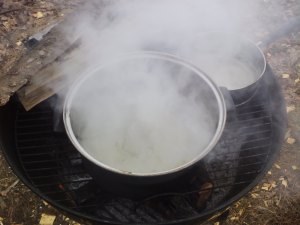Sean Murphy stood in his 12 by 14 foot cabin, stirring the maple sap that he had just collected. Long curls protruded from beneath his bandana as a smile crept across his face, “the sap is starting to turn brown.”
Murphy collects tree sap behind his cabin and has two taps running collecting sap in five pound buckets, and two more collecting the sap in mason jars. “You want to tap the tree above a large root, that’s where you get the most sap,” said Murphy as he drilled a hole into a large maple using an old-school hand drill.
Once the tap is inserted into the tree, the sap trickles out, dripping into the deep bucket drop after drop. Whereas I expect a stream, I am left wondering at how slow of a process collecting sap really is. Surprisingly all the small driblets add up.
At 23 years old, this is Murphy’s first year of collecting sap and making syrup. As a beginner, he seems confident in what he’s doing. Collecting sap is not a job just for professionals and maple houses, anyone and everyone can do it, all it takes is time.
According to Murphy, collecting sap has a lot to do with weather, the days need to be warm but the nights need to still be cold, which is what makes the sap run during the spring.
After collecting between 3 and 4 gallons of sap over a period of a few days, Murphy builds a fire over which he steams the sap. As he watches it steam, he drinks some uncooked sap, “I almost prefer it this way.”
As the sap begins to boil, steam billows out of the pot as evaporating water leaves a darker and darker solution. As the sap boils down it quickly shrinks. According to Murphy, 40 pounds of sap will result in about 1 pound of syrup.
As we wait for the sap to boil, we sit in Murphy’s cabin. During the winter, Murphy works on concocting his own hard cider that bubbles away in the corner of the cabin near his woodstove. Between the bubbling of his cider, the brewing of his maple sap, and the painted mountain corn and sage hanging from the beams across his ceiling it is evident Murphy is working toward a lifestyle of self-efficiency.
“Imagine how easy it is to make this syrup, you could easily make enough syrup in the spring to last you a year, at least,” said Murphy, before heading back out to the fire to replace logs and keep the sap boiling.
The longer the sap boils the darker it becomes. As the sap turns a deep bronze and is near done Murphy’s boss, Dennis Fisher who owns the vegetable farm Murphy works on, stops by to check on the sap. As he nods at Murphy’s work, Fisher mentions that an issue he’s often faced with while jarring his own syrup, is that it begins to mold even before he opens the jars. “That’s when I stopped bothering with my own sap.”
In order to try and avoid this problem, Murphy cleans the jars thoroughly and follows the cleaning with a kettle full of boiling water, which he pours over the jars and their lids, in order to ensure that they are sterilized.
As Murphy pours his now chestnut colored syrup into the jars, he manages to harvest a little less than two 8 oz. jam jars full. Surprisingly, this syrup isn’t the thick syrup that most of us are used to, but instead it runs around the glass as water would.
After the day of syrup manufacturing has come to a close for Murphy, he returns all buckets to the maple trees and waits as his next and last batch of the season slowly trickles down through his taps.
-Anna Mueller
